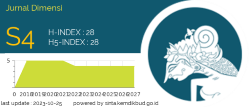PENINGKATAN PRODUKTIVITAS PADA LINE ASSEMBLY STOPPER CRASH STOP DENGAN LINE BALANCING
Abstract
PT. XYZ is manufacturing company, it produces HDD (Hard Disk Drive) components with plastics and rubber material. One of HDD products which used rubber material is Stopper Crash Stop, it’s produced by assembly process. The actual productivity from July – September 2013 indication that have average productivity is less than the standard. The actual productivity is 8,949 Pcs/man/day, but the standard productivity is 10,350 Pcs/man/day. The Main Root Causes, which contribute to productivity of assembly line of Stopper Crash Stop less than the standard are workplace that more than range of operator’s hand, time of machines operation are different, work load are not balanced. And to increase the productivity of assembly line Stopper Crash Stop to achieve the standard done by Kaizen concept in phases and sustainable. 1st kaizen is layout kaizen, re-layout table of vibration machine by make sit position of operator A and operator B is equal. 2nd kaizen is machine kaizen, standardize time of machines operation refers to the fasters one. 3rd kaizen is layout kaizen, optimize wide of table for vibration machine. And 4th kaizen is line balancing kaizen, make work load of operator is balance. The Productivity before kaizen is 8,949 Pcs/man/day and the productivity after kaizen is 12,323 Pcs/man/day (the productivity increases 38%).
Full Text:
PDFReferences
Bailey, B.D & Liu, P.C (1998). Electronics Manufacturing Company Hand Assembly Productivity Improvement, Industrial Technology, 15 (1), 1-4.
Chakraborty, A., dkk (2013), Importance of Kaizen Concept in Medium manufacturing Enterprises, International Journal of Management and Strategy, 4 (6), 1-11.
Chen, J. C., dkk, A Kaizen Based Approach for Cellular Manufacturing System Design: A Case Study , The Journal of Technology Studies, 19 – 27.
Emeke, O. & Offiong, A. (2013), Productivity Improvement in Breweries Through Line Balancing Using Heuristic Method, International Journal Publications Of Problems & Application In Engineering Research,04 (01), 19-26.
Gautam, R., dkk (2012), Kaizen Implementation in an Industry in India: A Case Study, International Journal of Research in Mechanical Engineering & Technology, 2 (1), 25 – 33.
Gomes, F. C. (2010), Managemen Sumber Daya Manusia, Yogyakarta: Andi Offset.
Handoko, T.H. (2008), Dasar-Dasar Manajemen Produksi dan Operasi (Edisi 1), Yogyakarta: BPFE.
Hemanand, H., dkk, Improving productivity of manufacturing division using lean concepts and development of material gravity feeder-a case study, Lean Thinking, 3 (2), 117-134.
Ikuma, L. H., dkk (2011), Use of Safety and Lean Integrated Kaizen to Improve Performance in Modular Homebuilding, Journal of Contruction Engineering and Management, 551 – 560.
Imai, M (2012), Gemba Kaizen: A Commonsense Approach To Continuous Improvement Strategy, (2nd edition), New York: McGraw-Hill.
Indrawan, Y & Hariastuti, N.L.P (2012), Minimalisasi bottleneck proses produksi dengan menggunakan metode line balancing, Jurusan Teknik Industri, Institut Teknologi Adhi Tama Surabaya.
James, J., dkk (2013), Productivity Improvement by Enhancing the Bottleneck Station in an Alternator Production Plant with Layout Improvement and Its Cost Analysis, International Journal of Scientific and Research Publications, 3 (9), 1-7.
Kadarisman, M. (2012), Managemen pengembangan sumber daya manusia, Jakarta: PT. Raja Grafindo Persada.
Kamlekar, N., dkk (2012), Implementation of Assembly Line Balancing in a Labour Intensive Manufacturing Unit, National Conference on Emerging Challenges for Sustainable Business, 1720-1730.
Komarudin & Saputra, R. (2012), Peningkatan efisiensi dan produktivitas kinerja melalui pendekatan analisis rangked positional weight method PT. X, Teknik Industri, Institut Sains dan Teknologi Nasional, 1-8.
Kumar, N & Mahto, D (2013). Productivity Improvement through Process Analysis for Optimizing Assembly Line in Packaging Industries, Global Journal of Researches in Engineering Industrial Engineering, 13 (3), 10-26.
Kusuma, H (2004), Managemen Produksi (Perencanaan dan Pengendalian Produksi), Yogyakarta: Andi Offset.
Lina Gozali, L., dkk (2012), Analisa keseimbangan lini pada departemen Chassis PT Toyota Motor Manufacturing Indonesia dengan algoritma ant colony, rank positional weight, dan algoritma genetika, Jurnal Teknik Industri, 119-126
Mandwe, P (2013), Productivity Improvement Of Crankshaft, Scientific & Technology Research, 2 ( 7), 207-209.
Marri, H.B. & Shaikh, G.Y. (2012), The Role of Productivity Improvement Tools and Techniques in the Textile Sector during Manufacturing, Proceedings of the 2012 International Conference on Industrial Engineering and Operations Management Istanbul ( Turkey), 2570-2573.
Pandit, S. V., dkk (2014), Productivity Improvement by Application of Line Balancing, International Journal of Innovative Research in Science, Engineering and Technology, 3 (4), 11495 – 11502.
Pei, L. M. & Tap, M. M. (2002), Improving productivity Through Line Balancing- A Case Study, Jurnal Mekanikal, 14, 48 – 62.
Prasad, M. M., dkk (2013), An Optimal Balancing Of Multiple Assembly Line For A Batch Production Unit, International Journal of Lean Thinking, 4 (2), 22 – 32.
Rajenthirakumar, D. & Thyla, P.R (2010), Quality and Productivity Improvement in Automotive Component Manufacturing Company Using Kaizen, 36-38.
Ramadhani, S (2012), Skripsi: Analisis Penerapan Konsep Penyeimbangan Lini (Line Balancing) Pada Sistem Produksi Percetakan harian Tribun di Makasar, Sulawesi: Universitas Hasanudin Makasar.
Rameez, H.M. & Inamdar, K.H. (2010), Areas of Lean Manufacturing for Productivity Improvement in a Manufacturing Unit, World Academy of Science, Engineering and Technology, 45, 584-587.
Rivai, V. & Sagala, E.J. (2013), Managemen sumber daya manusia untuk perusahaan, Jakarta: PT. Raja Grafindo Persada.
Roy, H.N., dkk, Productivity Improvement of a Fan Manufacturing Company by using DMAIC Approach: A Six-Sigma Practice, Global Journal of Researches in Engineering Industrial Engineering, 13 (4), 1-6.
Saeheaw, T., dkk (2009), Line Balancing in the Hard Disk Drive Process Using Simulation Techniques, World Academy of Science, Engineering and Technology, 3, 593 – 597.
Sihombing, H., dkk (2011), Line balancing Analysis of Tuner Product Manufacturing, International Journal of Engineering Science and Technology (IJEST), 3 (6), 5206 – 5214.
Sugiyono (2013), Metode penelitian kuantitatif dan kualitatif dan R&D, Bandung: Alfabeta.
Sunyoto, D. (2013), Manajemen sumber daya manusia, Jakarta: CAPS (Center for Academic Publishing Service).
Uehira (2011), Seven waste (Hand book Improvement Training), Jepang: MPCJ.
DOI: https://doi.org/10.33373/dms.v5i1.26
Refbacks
- There are currently no refbacks.











